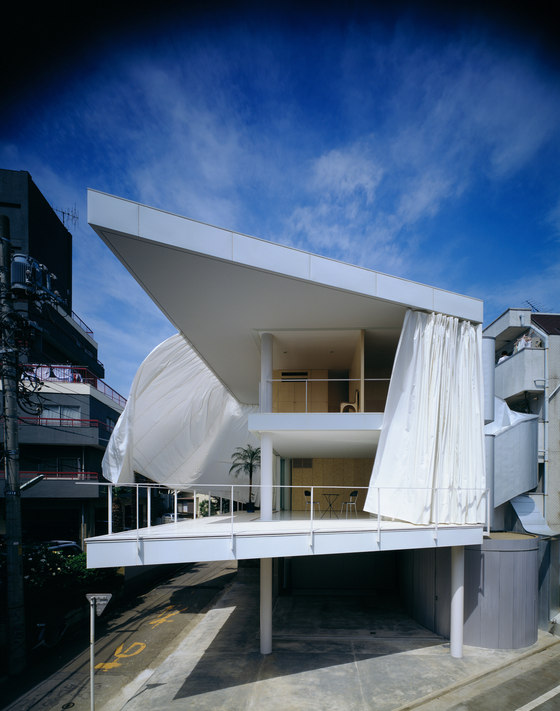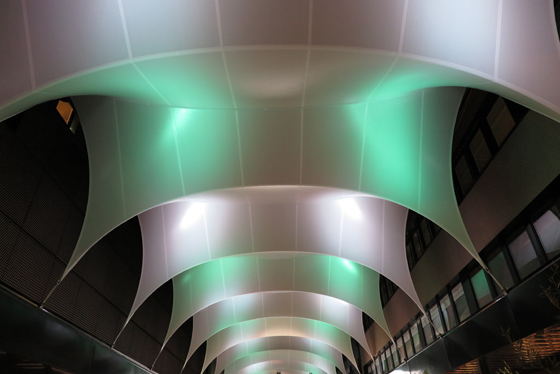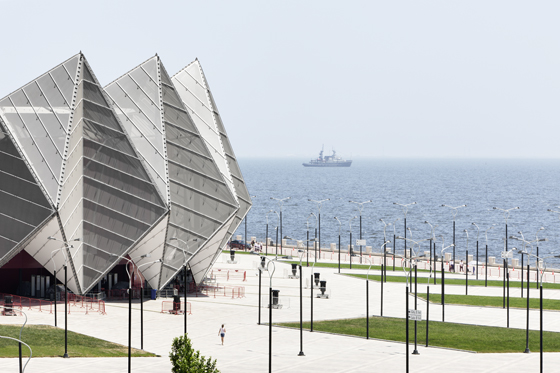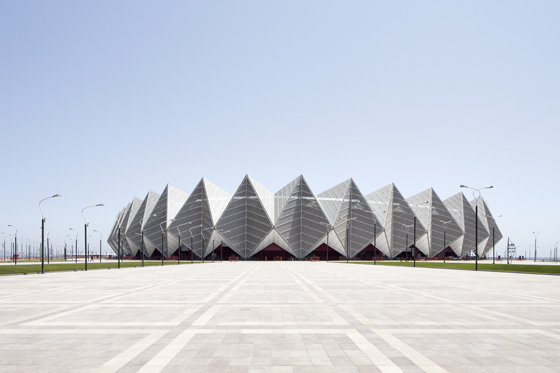Architexture: textiles go constructional
Texto por Dominic Lutyens
London, Reino Unido
21.04.15
Its roots may lie in transient structures, but contemporary textile architecture, with all its creative, functional and ecological possibilities, is definitely here to stay.
Constructed in just eight months, GMP Architekten and Nüssli International’s show-stopping 25,000-seater Baku Crystal Hall in Azerbaijan features an angular facade made of reflective PVC-PES mesh fabric and PVC-coated polyester

Constructed in just eight months, GMP Architekten and Nüssli International’s show-stopping 25,000-seater Baku Crystal Hall in Azerbaijan features an angular facade made of reflective PVC-PES mesh fabric and PVC-coated polyester
×The structural use of textiles in architecture has a rich pedigree, stretching back (no pun intended) to Bedouin tents and 3,000-year-old Central Asian yurts. Today, structures with membrane roofs are highly sought-after and, not surprisingly, have associations of transience and nomadism. Baku Crystal Hall in Azerbaijan, a 25,000-seater stadium, which hosted the 2012 Eurovision Song Contest, was conceived as temporary (but later adapted to remain in place longer).
In the 20th century, textiles used in architecture had strong eco connotations. Take the Olympics Stadium in Munich of 1972, co-designed by Otto Frei with a view to minimising its impact on the environment, and green architecture pioneer Lloyd Kahn’s 1973 book ‘Shelter’, which celebrated simple, ancient dwellings such as tepees.
Shigeru Ban’s Curtain Wall House in Tokyo is defined by its curtain-like, fabric ‘walls’, which the architect likens to traditional shoji screens; photo: Hiroyuki Hirai
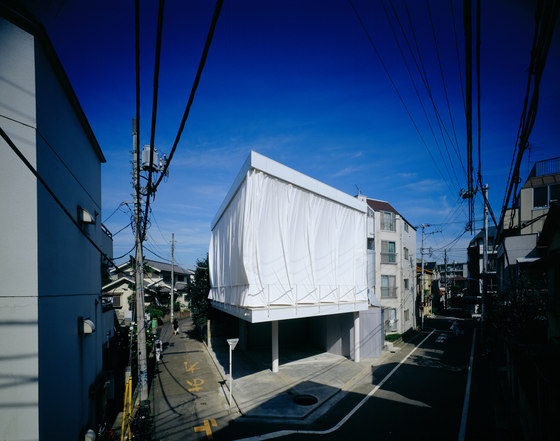
Shigeru Ban’s Curtain Wall House in Tokyo is defined by its curtain-like, fabric ‘walls’, which the architect likens to traditional shoji screens; photo: Hiroyuki Hirai
×While textiles today are often deployed for their tensile qualities on state-of-the-art stadia and other sophisticated membrane structures, some architects have been drawn to their softness and fluidity, suggestive of informality. Shigeru Ban fronted his 1995 Curtain Wall House in Tokyo with gigantic, tent-like curtains which, when drawn, allow it to be as open as possible to the outside world — a metaphor, too, for his client’s free, open, sociable mindset. Ban also saw the curtains as ‘a membrane taking the place of shoji screens in traditional Japanese houses’.
Made of Sefar’s Tenara fabric, architect Nikolai Kugel’s visually intriguing canopy over the Metzergasse in Buchs, Switzerland, was wind-tunnel-tested before installation and is fully retractable

Made of Sefar’s Tenara fabric, architect Nikolai Kugel’s visually intriguing canopy over the Metzergasse in Buchs, Switzerland, was wind-tunnel-tested before installation and is fully retractable
×Poetic qualities aside, textiles used in architecture meet a fundamental, practical need for shelter. For a pedestrian street called Metzergasse in Buchs, Switzerland, architect Nikolai Kugel has created a canopy made using Sefar’s colourfast and dirt- and tear-resistant Tenara fabric. Shoppers are shielded from sun and rain, while the fabric overhead, which has been extensively wind-tunnel-tested, can rebuff the Swiss-Austrian Rhine Valley’s strongest winds. The canopy is retractable, and covers the street in minutes automatically.
Respected Norwegian office chose to collaborate with leading high-tech-membrane manufacturer MDT-tex when it came to shaping the exterior landscape of its new King Abdulaziz Center for World Culture in Saudi Arabia
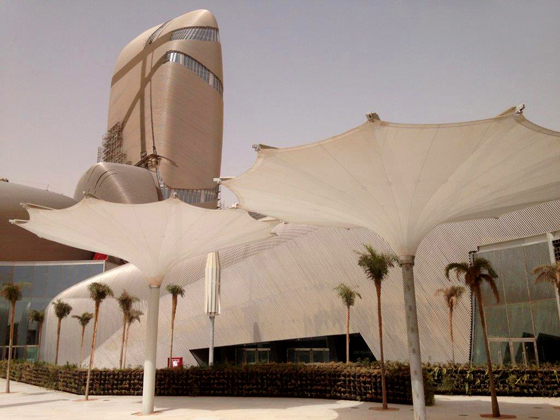
Respected Norwegian office chose to collaborate with leading high-tech-membrane manufacturer MDT-tex when it came to shaping the exterior landscape of its new King Abdulaziz Center for World Culture in Saudi Arabia
×When designing the King Abdulaziz Center for World Culture in Saudi Arabia recently, Norwegian office Snøhetta collaborated with high-tech-membrane manufacturer MDT-tex to dream up parasol-like structures made of the latter’s waterproof, UV-resistant MDT-PTFE fabric. Their idiosyncratic, inverted umbrella forms are in fact functional — they resist storms and fierce winds. And their Teflon-coated, self-cleaning canopies help prevent them ageing, suggesting that, unlike traditional tented structures, these could remain rooted here for years.
The Baku Crystal Hall’s facade consists of mesh-fabric and coated-polyester diamond and triangular-shaped panels across an aluminium frame, together with 9,500 LED lights that illuminate the stadium at night
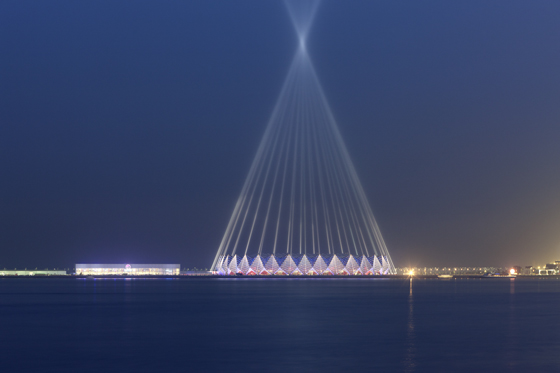
The Baku Crystal Hall’s facade consists of mesh-fabric and coated-polyester diamond and triangular-shaped panels across an aluminium frame, together with 9,500 LED lights that illuminate the stadium at night
×Another advantage of membrane structures is that they can be erected relatively quickly: Baku Crystal Hall – co-designed by GMP Architekten and Nüssli International and built by Alpine Bau Deutschland – was completed in eight months, thanks in part to its modular structure in three parts (membrane facade, arena and roof section). The facade’s diamond and triangular-shaped panels – made of a reflective PVC-PES mesh fabric and PVC-coated polyester – are reinforced with aluminium clamping bars, which also house cables for the 9,500 LED lights that illuminate the stadium at night.
Baku Crystal Hall, it seems, is lighting the way for further advances in architecture constructed from high-performance textiles.

